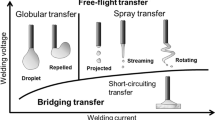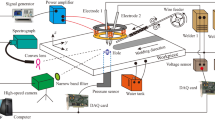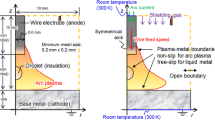Abstract
In the CO2 welding process, a consumable wire electrode is used and metal transfer phenomena are involved. However, when the arc current is high, the molten wire behavior becomes unstable, and it leads to a large degree of spattering. In this study, a three-dimensional unified model comprising both the arc plasma and the molten wire was constructed, and the behavior of them was visualized using numerical simulations. The transfer mode is regarded as globular transfer in the numerical simulation with an arc current of 300 A. In addition, when the molten metal droplet becomes asymmetrical, the molten wire is pushed up by the arc plasma, and the transfer mode becomes repelled transfer. The temperature distribution and the metal vapor concentration distributions in the symmetrical and asymmetrical cases are significantly different. When the droplet shape is close to symmetrical, the metal vapor concentrates at the center of the arc plasma and the overall temperature of the arc plasma decreases. In contrast, when the droplet shape is asymmetrical, the high-temperature region and metal vapor region are separated. The numerical results showed that the properties of the arc plasma are significantly changed depending on the molten wire behavior.











Similar content being viewed by others
References
Ruckdeschel WEW. Classification of metal transfer, IIW Doc. XII-636-76. 1976.
Ludwig HC (1957) Metal transfer characteristics in gas-shielded arc welding. Weld J 36:23s–26s
Needham JC, Cooksey CJ, Milner DR (1960) Metal transfer in inert-gas shielded-arc welding. Br Weld J 7:101–114
Liu S, Siewert TA (1989) Metal transfer in gas metal arc welding: droplet rate. Weld J 68:52s–58s
Lesnewich A (1958) Control of melting rate and metal transfer in gas-shielded metal-arc welding part II - control of metal transfer. Weld J 37:418s–425s
Rhee S, Kannatey-Asibu E Jr (1992) Observation of metal transfer during gas metal arc welding. Weld J 71:381s–386s
Valensi F, Pellerin S, Boutaghane A, Dzierzega K, Zielinska S, Pellerin N, Briand F (2010) Plasma diagnostics in gas metal arc welding by optical emission spectroscopy. J Phys D Appl Phys 43:434002
Rouffet ME, Weldt M, Goett G, Kozakov R, Shoepp H, Weltmann KD, Uhrlandt D (2010) Spectroscopy investigation of the high-current phase of a pulsed GMAW process. J Phys D Appl Phys 43:434003
Methong T, Shigeta M, Tanaka M, Ikeda R, Matsushita M, Kataoka T (2017) Diagnostic of heat source characteristics in gas metal arc welding using CO2 shielding gas. Q J Jpn Weld Soc 35(2):103s–107s
Simpson SW, Zhu P (1995) Formation of molten droplet at a consumable anode in an electric welding arc. J Phys D Appl Phys 28:1594–1600
Choi SK, Yoo CD, Kim Y-S (1998) Dynamic simulation of metal transfer in GMAW, part 1: globular and spray transfer modes. Weld J 77:38s–44s
Choi SK, Yoo CD, Kim Y-S (1998) The dynamic analysis of metal transfer in pulsed current gas metal arc welding. J Phys D Appl Phys 31:207–215
Wang G, Huang PG, Zhang YM (2003) Numerical analysis of metal transfer in gas metal arc welding. Metall Mater Trans B 34B:345–353
Kadota K, Hirata Y (2011) Numerical model of metal transfer using an electrically conductive liquid. Weld World 55(09/10):50–55
Wang F, Hou WK, Hu SJ, Kannatey-Asibu E, Schultz WW, Wang PC (2003) Modelling and analysis of metal transfer in gas metal arc welding. J Phys D Appl Phys 36:1143–1152
Haidar J, Lowke JJ (1996) Predictions of metal droplet formation in arc welding. J Phys D Appl Phys 29:2951–2960
Hu J, Tsai HL (2007) Heat and mass transfer in gas metal arc welding. Part II: the metal. Int J Heat Mass Transf 50:808–820
Hertel M, Spille-Kohoff A, Fuessel U, Schnick M (2013) Numerical simulation of droplet detachment in pulsed gas-metal arc welding including the influence of metal vapour. J Phys D Appl Phys 46:224003
Ogino Y, Hirata Y (2015) Numerical simulation of metal transfer in argon gas-shielded GMAW. Weld World 59:465–473
Ogino Y, Hirata Y, Murphy AB (2016) Numerical simulation of GMAW process using Ar and an Ar-CO2 gas mixture. Weld World 60:345–353
Xu G, Hu J, Tsai HL (2009) Three-dimensional modeling of arc plasma and metal transfer in gas metal arc welding. Int J Heat Mass Transf 52:1709–1724
Wilke CR (1950) A viscosity equation for gas mixtures. J Chem Phys 18(4):517–519
Hirt CW, Nichols BD (1981) Volume of fluid (VOF) method for the dynamics of free boundaries. J Comput Phys 39:201–225
Brackbill JU, Kothe DB, Zamach C (1992) A continuum method for modeling surface tension. J Comput Phys 100:335–354
Rao ZH, Hu J, Liao SM, Tsai HL (2010) Modeling of the transport phenomena in GMAW using argon–helium mixtures. Part I – the arc. Int J Heat Mass Transf 53:5707–5721
Ushio M, Wu CS (1997) Mathematical modeling of three-dimensional heat and fluid flow in a moving gas metal arc weld pool. Metall Mater Trans B 28B:509–516
Murphy AB (1995) Transport coefficients of air, argon-air, nitrogen-air and oxygen-air plasmas. Plasma Chem Plasma Process 15:279–307
Murphy AB, Arundell CJ (1994) Transport coefficients of argon, nitrogen, oxygen, argon-nitrogen and argon-oxygen plasmas. Plasma Chem Plasma Process 14:451–490
Murphy AB (2010) The effect of metal vapour in arc welding. J Phys D Appl Phys 43:434001
Funding
This research was supported by JSPS KAKENHI Grant Number JP19K15323.
Author information
Authors and Affiliations
Corresponding author
Additional information
Publisher’s note
Springer Nature remains neutral with regard to jurisdictional claims in published maps and institutional affiliations.
Recommended for publication by Study Group 212 - The Physics of Welding
Rights and permissions
About this article
Cite this article
Ogino, Y., Asai, S. & Hirata, Y. Visualization of arc plasma and molten wire behavior in CO2 arc welding process by three-dimensional numerical simulation. Weld World 64, 1789–1797 (2020). https://doi.org/10.1007/s40194-020-00958-4
Received:
Accepted:
Published:
Issue Date:
DOI: https://doi.org/10.1007/s40194-020-00958-4




